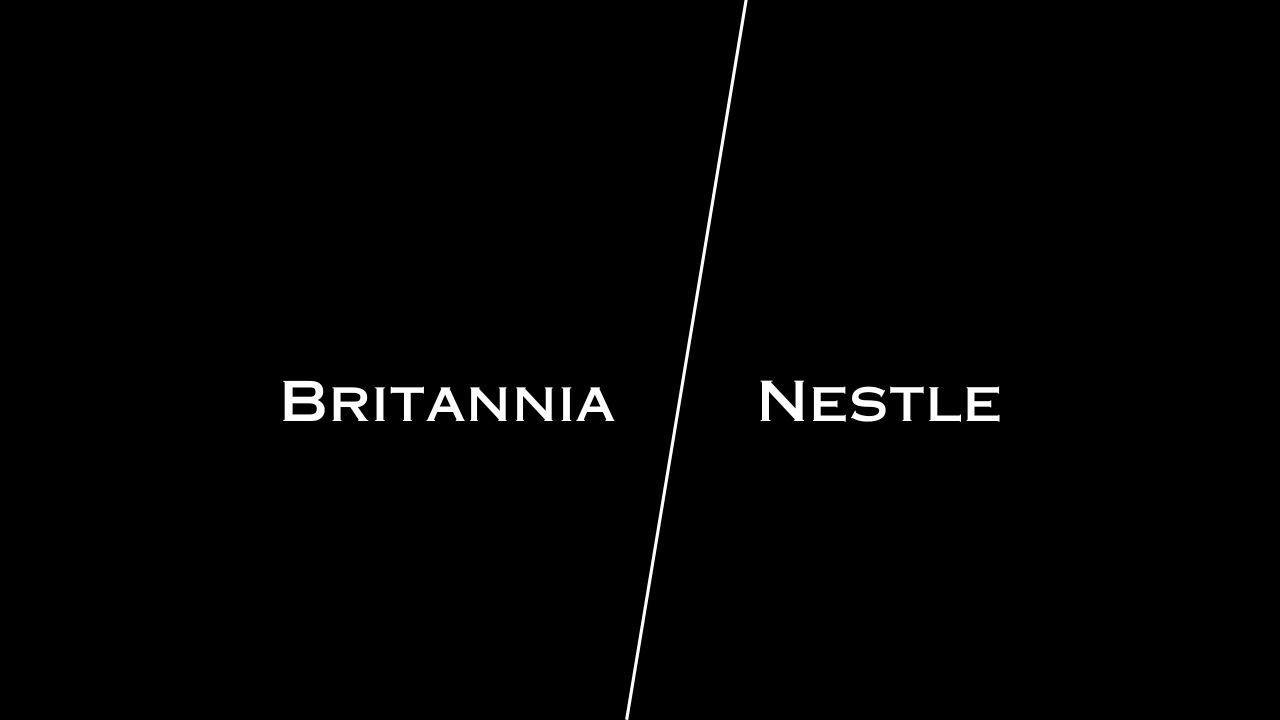Introduction
The fast-moving consumer goods (FMCG) sector is the fourth largest sector in the Indian economy. Food and beverages account for 19% of this sector.
The food industry in India has been evolving since India opened up for global trade. The scenario went from major international players selling their products in the country to India exporting its products to all developed and developing countries.
The industry has also seen significant changes with increasing disposable income, penetration in rural areas, and e-commerce. Two major players in this rapidly evolving Confectionery industry are Nestle India and Britannia Industries.
Nestle India is a subsidiary of Nestle SA, one of the largest food and beverage companies in the world.
The company primarily manufactures milk and nutrition products, prepared dishes, cooking aids, and chocolates and confectionery. It has market leadership in several business categories including prepared dishes, cooking aids, and chocolates.

Britannia Industries is among India’s leading food companies and is a part of the Wadia Group, a reputed Indian business house.
Its products are spread across multiple business segments, including biscuits, bread, cakes, rusk, dairy products, and salted snacks. Britannia is a well-established Indian brand and has market leadership in the biscuits segment. It is also the largest player in the organized bread segment.
Britannia is a leading Indian company specializes in baked goods, including biscuits, cakes, and bread, which has expanded its reach to other countries.

Product Portfolio
Nestle’s has a diversified product portfolio. It continuously launches new products to stay ahead of its competition. It already has an international presence through its parent company.
On the other hand, Britannia has established itself as the biscuit maker in the country and is growing its international footprint.
| Nestle | Britannia | |
|---|---|---|
| Business Segments | Milk and nutrition Prepared dishes and cooking aids Chocolates |
Biscuits Bread Cakes Rusk Dairy products Salted snacks |
Financial Strength
Return on capital employed (ROCE)
Return on capital employed measures the company’s efficiency in generating profits from the capital invested.
The five-year average ROCE for Nestle and Britannia is 92.2% and 46.5%, respectively.
| ROCE (%) | 2016-2017 | 2017-2018 | 2018-2019 | 2019-2020 | 2020-2021 |
|---|---|---|---|---|---|
| Nestle | 49.4% | 55.9% | 68.5% | 142.1% | 145.1% |
| Britannia | 48.1% | 43.9% | 41.4% | 37.4% | 61.5% |
Profit margins
Operating profit margin indicates what percentage of the operating revenue is the profit after paying for all operating expenses.
Nestle is leading with a five-year average operating profit margin of 22.6% against 16.1% of Britannia.
| 2016-2017 | 2017-2018 | 2018-2019 | 2019-2020 | 2020-2021 | |
|---|---|---|---|---|---|
| Operating Profit Margin (%) | |||||
| Nestle | 20.9% | 21.3% | 23.2% | 23.6% | 23.9% |
| Britannia | 14.6% | 15.3% | 15.7% | 15.7% | 19.1% |
| Net Profit Margin (%) | |||||
| Nestle | 11.4% | 12.5% | 14.2% | 15.9% | 15.6% |
| Britannia | 10.1% | 10.2% | 10.5% | 12% | 14.1% |
Differences
- Because they are well-known brands, their growth rates are distinct from one another. Nestle has a 20% market share, whereas Britannia has an 18% market share.
- The famous product domain of both of these brands differs. Nestle is known for the culinary and beverage segment whereas Britania is known for biscuit production.
- The operating margin of nestle is 20% whereas the operating margin of Britannia is 6.5%.
- ROE of both of these organizations also differs. ROE of nestle is 90% whereas the ROE of the Britannia brand is 44%.
- There are many well-known products which are associated with these brands well know products for Britannia is Good Day, 50-50, Nutri-choice, Tiger, Treat, and Milk Bikis whereas Nestle is known for the products Everyday dairy whitener, Cerelac, Lactogen, Milkmaid, Nescafe, Maggi, Kit-Kit, Munch, Bar-One and Polo.
Stock Recommendation
The stock buy should be based on the dividend payout over the period of previous years.
| 2016-2017 | 2017-2018 | 2018-2019 | 2019-2020 | 2020-2021 | |
|---|---|---|---|---|---|
| Dividend Payout Ratio (%) | |||||
| Nestle | 60.7% | 67.7% | 69% | 167.5% | 92.6% |
| Britannia | 14.9% | 14.9% | 31.2% | 60.4% | 221% |
| Average Dividend Yield (%) | |||||
| Nestle | 1% | 1.2% | 1.2% | 2.7% | 1.3% |
| Britannia | 0.4% | 0.3% | 0.3% | 1.3% | 5.2% |
In terms of valuation, Nestle’s shares are overpriced compared to Britannia. However, compared to their five-year averages, both the shares are overpriced.
Though both Nestle and Britannia are a part of the food industry, there is only a slight overlap in their segments and cater to different customer needs.
Work Culture
The overall rating of both Britannia & Nestle is 4.1. Britannia is rated higher than Nestle for job security, work satisfaction and career growth, whereas Nestle is rated higher for company culture.
Both Britannia and Nestle are rated 3.7/5.0 for work-life balance. At Britannia, 71% of employees reported working from Monday to Friday, and 59% mentioned having flexible timings. For Nestle, 63% of employees reported working from Monday to Friday, and 56% mentioned having flexible timings.
Future Aspects
Nestle and Britannia, both, have taken various steps to reduce their carbon footprint.
Nestle has reduced its greenhouse gas emissions by over 53% and energy consumption by over 48% in the last 15 years.
It is also focusing on sustainable operations by increasing its use of railways and waterways to transport its products. Nestle is also plastic neutral and focuses on responsibly sourcing its raw materials.
Britannia aims to use 100% recyclable or reusable packaging by the end of 2024. It has taken steps to reduce its usage of plastic and paper in packing its products.
The company has also increased its usage of renewable energy sources and reduced its usage of water and energy in the past few years.
Going forward, Britannia and Nestle both have a host of opportunities in front of them to expand. Both the companies are well equipped to capitalize on the opportunities.
Nestle is already ensuring the rural demand is being met through its penetration strategy. It’s identifying the changing customer needs and is launching innovative products rapidly.
Britannia, on the other hand, has identified that the per capita consumption of biscuits in India (2 kgs) is much lower than some developed countries (10 kgs). It has re-introduced Milk Bikkis with 100% Atta (wheat) with attractive advertising.
It is also increasing its distribution network, both online and offline, using technology.
With changing customer preferences, the company is also launching new flavours in all its product categories and creating a market for itself.
Conclusion
Nestle is a global food and beverage company with a diverse product range, including baby food, bottled water, and confectionery. Britannia is an Indian food company primarily known for its bakery products, such as biscuits and cakes.
Nestle has a broader international presence and product portfolio than Britannia, focusing on the Indian market and specific food categories.
As per the expert, both the FMCG companies, Nestle and Britannia have shown healthy growth in the past few years and have witnessed strong demand from the rural segment, hence are strategically planning market penetration in the market.
Nestle had growth at a decadal high and is keeping the growth momentum with new product launches and strong consumer sentiment on fire by premiumization and innovation and even Britannia is no guest to innovation, she noted. The company has launched various products, across categories from Western snacks to dairy to biscuits. However, Britannia is still not done exploring the rural markets and at the current valuation, thus poses to be a good investment opportunity




